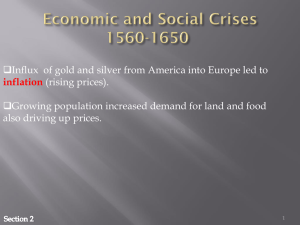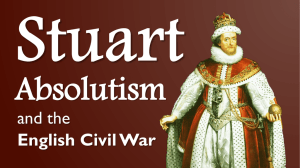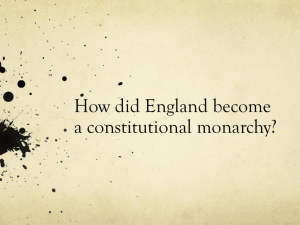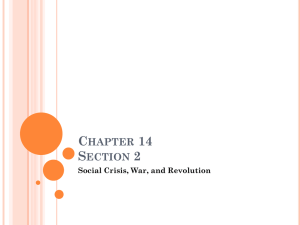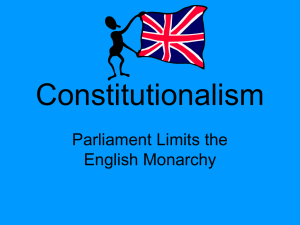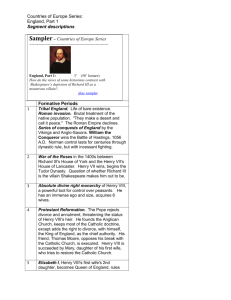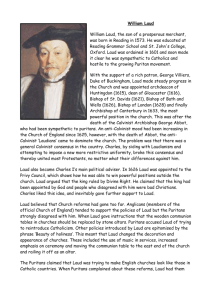English Civil War
advertisement
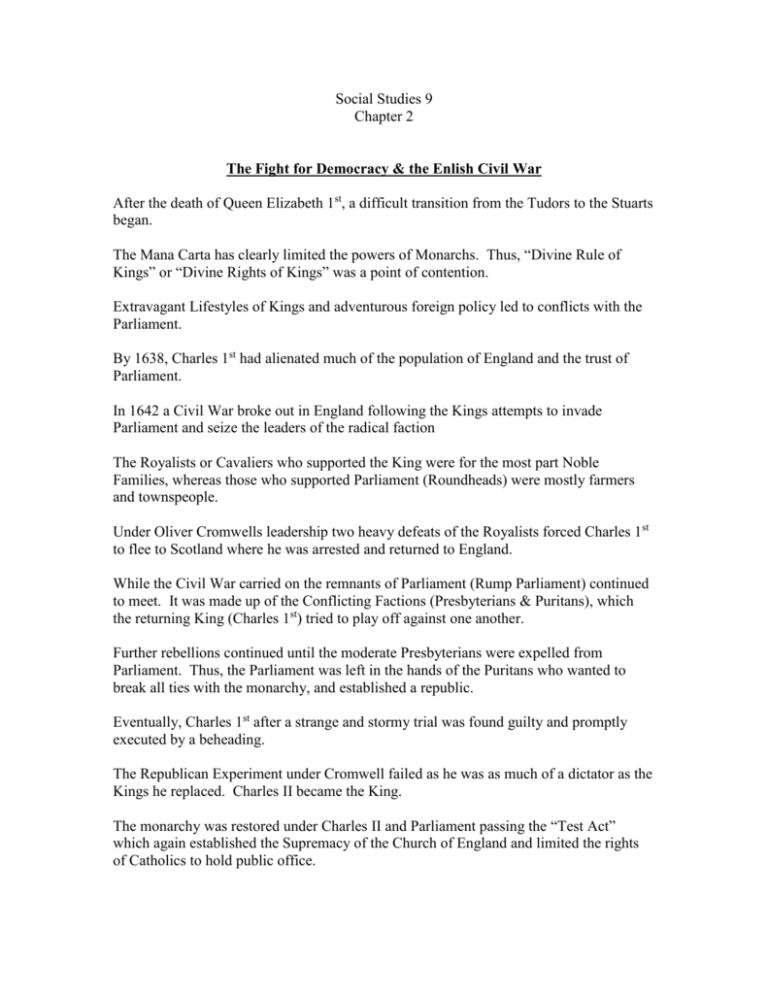
Social Studies 9 Chapter 2 The Fight for Democracy & the Enlish Civil War After the death of Queen Elizabeth 1st, a difficult transition from the Tudors to the Stuarts began. The Mana Carta has clearly limited the powers of Monarchs. Thus, “Divine Rule of Kings” or “Divine Rights of Kings” was a point of contention. Extravagant Lifestyles of Kings and adventurous foreign policy led to conflicts with the Parliament. By 1638, Charles 1st had alienated much of the population of England and the trust of Parliament. In 1642 a Civil War broke out in England following the Kings attempts to invade Parliament and seize the leaders of the radical faction The Royalists or Cavaliers who supported the King were for the most part Noble Families, whereas those who supported Parliament (Roundheads) were mostly farmers and townspeople. Under Oliver Cromwells leadership two heavy defeats of the Royalists forced Charles 1st to flee to Scotland where he was arrested and returned to England. While the Civil War carried on the remnants of Parliament (Rump Parliament) continued to meet. It was made up of the Conflicting Factions (Presbyterians & Puritans), which the returning King (Charles 1st) tried to play off against one another. Further rebellions continued until the moderate Presbyterians were expelled from Parliament. Thus, the Parliament was left in the hands of the Puritans who wanted to break all ties with the monarchy, and established a republic. Eventually, Charles 1st after a strange and stormy trial was found guilty and promptly executed by a beheading. The Republican Experiment under Cromwell failed as he was as much of a dictator as the Kings he replaced. Charles II became the King. The monarchy was restored under Charles II and Parliament passing the “Test Act” which again established the Supremacy of the Church of England and limited the rights of Catholics to hold public office. NOTE: Remember that both Ireland and Scotland were strong supporters of the King Charles II. Northern Ireland was promptly resettled with English and Scottish Protestants, making the stronghold of the Protestants in Ireland. By 1660 General Monk (The North Commander of the Army) fearing another Civil War, reconvened Parliament and restored Charles II as leader. However, the Parliament decided that the King must rule under the laws of a constitutional monarchy and his powers were set out by Parliament. Supporters of the King became known as “Tories” and those opponents known as “Whigs”. Puritans based blue laws were soon overturned and England eventually returned to the theatre and entertainment. In an attempt to warn others against plotting to harm the King “Regicides” were horribly tortured as a statement to others. In 1685 Charles II died and was succeeded by his Catholic brethren James II. By ancient right England became ruled by a Catholic in a very Anti-Catholic country. Due to his manner of governing, rebellions broke out and James II quickly lost his power. By 1688-89 James II abdicated his throne to Mary (James Protestant daughter) and her husband William of Orange. This became known as the Glorious Revolution. “Divine Right of King” was now dead. NOTEWORTHY FACTS 1689 – The Bill of Rights The Stuarts: A dynasty that originated in Scotland and ruled England following the death of Queen Elizabeth I. The Stuarts disliked the Democratic traditions practiced in England. James I (Formerly James VI of Scotland) was a descendant of Mary Queen of Scots, who was also a Stuart and executed by Queen Elizabeth. James I introduced “Divine Right of Kings” to England where it was very unpopular. The Stuarts believed in Absolute Power and this led to clashes in Parliament, the English Civil War and the death of Charles II. James I was not a very tactful ruler. Often he was viewed as a Tyrant. Because of his methods of ruling, England suffered financial hardships. James I also disliked the Puritans, and tried to anger them whenever he could. When he died, his son Charles I inherited a divided kingdom that was very dissatisfied with Government. Charles I filled in well for his father. He led an extravagant lifestyle and was very stubborn and unwilling to bend. Most important was that Charles I was advised by the Duke of Buckingham, who gained his title James I (Charles I father). The problem was that the Duke of Buckingham was a very poor decision maker, and hated by the majority of people. Charles I ruled by Divine Right and rarely consulted Parliament. “The Petition of Right” in 1628 brought forth by Parliament was an attempt to make Charles I govern England in a legal manner. When the Duke of Buckingham was assassinated he was replaced by Lord Strafford and Archbishop Laud, both disliked by their peers. By 1637 Charles I was in a financial mess. Unfortunately Parliament would not support Charles I when Laud and Strafford were handed over to Parliament in a deal they were executed. Laud was the Head of the Church of England and he had antagonized the Puritans for years. By 1640 Charles I had not yet received the money he needed to suppress the Scots. Parliament was still at a dilemma. They were not sure how much power a King actually had. When Parliament barely passed the GRAND REMONSTRANCE ACT, Charles I saw an opportunity to invade the House of Commons and arrest those who voted for it. To pay for the Army that he would require, he sold the CROWN JEWELS. Soon open rebellion would follow.

